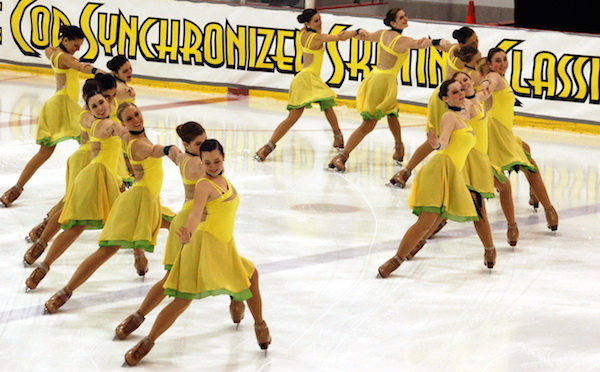In 2015 Dear Sports Fan will be previewing the biggest sporting event of the year in each of the 50 states in the United States plus the district of Columbia. Follow along with us on our interactive 2015 US Map.
Rhode Island — U.S. Figure Skating Synchronized Skating Championships
Synchronized Skating — February 25-28, 2015
Rhode Island is the smallest state in the country and one of the strangest. It has a long tradition of being on the cutting edge of sporting events. It hosted the country’s first outdoor polo match in 1876, the first open golf tournament in 1895, and the first national lawn tennis championship in 1899. The state is well-known for its hosting of folk and jazz music festivals in Newport. Even the circus first came to Rhode Island in 1774! This year, the biggest sporting event of the year is the U.S. Figure Skating Synchronized Skating Championships.
Synchronized skating is admittedly, not a very well-known sport, but it has a lot going for it. Synchronized skating is seriously athletic! Like synchronized swimming, which is an Olympic sport, synchronized skating features individual athletes performing feats that most people couldn’t dream of doing alone, much less in completely regimented, virtually flawless lock-step with a team full of athletes performing the same tricks.
The championships will not, as far as I can tell, be televised or available in a streaming fashion, so you’ll have to head over to the Dunkin’ Donuts center in Providence, Rhode Island, to see them in person. The schedule is available here and generally follows a young to old pattern, with the younger teams starting on Wednesday and doing most of their routines before the tournament transitions to its most serious divisions Friday night into Saturday.
How does synchronized skating work?
Synchronized skating is a team sport where groups of ice skaters perform coordinated dance-like routines to music. Synchronized skating is a judged sport, just like the individual or pairs figure skating you might be used to watching in the Winter Olympics. Teams consist of between 12 and 20 people depending on the level of competition (from Tot to Youth to Collegiate to Senior.) One of the coolest things about the sport is that, although most of the participants are female, there are no sex or gender requirements whatsoever. It’s a totally egalitarian sport. In competitions, each team will perform two routines, a short program and a free skating routine. Like in Olympic skating, the short program is all about performing difficult technical elements while the free skate’s length allows for more artistic expression. Each routine is scored before the competition based on how difficult it is. During a competition, the judges will be looking to see how well a team executes the planned routine. A more difficult routine therefore has a higher potential score than an easier routine. A lot of a sport’s strategy must be about finding the exact right balance between too easy and too risky.
Each routine must have a set of required elements, although there is room for variation and creativity within the rules. The Wikipedia page on the sport has a list of these elements and nice descriptions of each. Many of them, like the Wheel, Block, Circle, Intersection, and Line requirements are descriptive of the overall shape of the team. If seen from above (or imagined) the entire team must do something in the shape of a wheel, block with three parallel lines, etc. Other requirements are about what skaters do within formations. For example, in a Spin move, each skater must spin the same number of rotations at the same speed as his or her teammates. To fulfill a Pair requirement the team must do something where pairs of skaters hold onto each other. The lifting of one skater by another, like in pairs figure skating, is allowed, and, since there are so many more skaters on the ice, synchronized skating teams sometimes do group lifts, like you might see from cheerleaders.
In an article about a local team going to the national championships, The Frederick News Post quotes the mother of a skater as saying that watching the team is like “watching a flock of birds.” That’s a very apt description. It’s hard to do the sport justice by describing it, you’ve really got to see it. Luckily, there’s Youtube! What you’re about to see is a routine by the most successful American Sychronized Skating program, the Haydenettes from Lexington, Massachussets. Their team has won the U.S. Championships every year but two since 1999! The performance is impressive for some of the same reasons that a fighter-plane flyover before a football game is — power, speed, and precision. I am guessing that the team’s name is an homage to another impressively synchronized team, the Rockettes. The difference with the Haydenettes, and the thing that makes this sport so cool, is that they’re on ice. The positive of being on ice is that it allows for speed, power, and fluidity that would be hard to achieve on solid ground. The downside, of course, is that any mistake is magnified. Get an inch off, and the ice will make that inch into a foot. Also, and it’s hard to emphasize this enough, being on ice means you are wearing deadly weapons on your feet while you move backwards at high speeds mere inches from a teammate who is herself moving backwards at the same speed. Talk about trust!
Who’s going to win?
Like most competitions that involve the creation of beauty — ballet, beauty pageants, cheer leading — my assumption is that beneath the surface, synchronized skating is every bit as competitive as football or ice hockey. With that in mind, there’s no way I’m betting against the reigning champion Haydenettes who will be competing not far from their home town. The two teams that could challenge them are the Miami University team and the Crystallettes from Dearborn Michigan.

